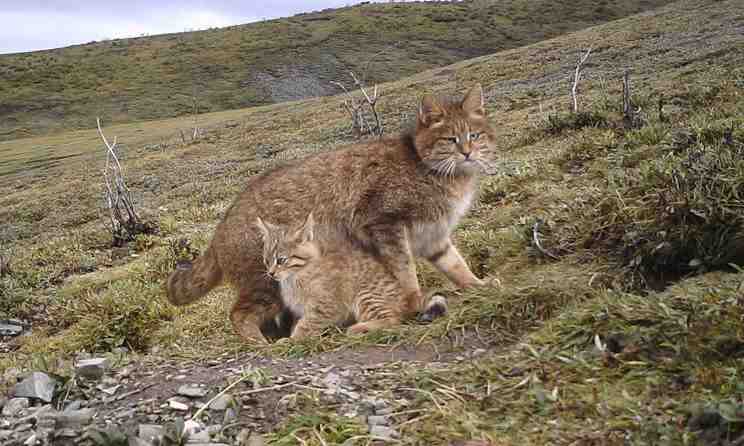Felis bieti
IUCN
LCBasic Information
Scientific classification
- name:Felis bieti
- Scientific Name:Felis bieti,Chinese Mountain Cat,Felis chutuchta,Grass cat, grass lynx, wild cat, desert cat, Chetang Xiongbu
- Outline:Carnivora
- Family:felidae f.subfamily G.felis
Vital signs
- length:61-68cm
- Weight:4-8kg
- lifetime:10yyears
Feature
The only endemic cat species in the country.
Distribution and Habitat
According to the latest survey, the exact distribution area of desert cats only includes four provinces and regions in China: Tibet, Qinghai, Gansu, and Sichuan.
They live in loess hilly dry grasslands, deserts, semi-deserts, grassland meadows, mountain coniferous forest edges, alpine shrubs, and alpine meadows at an altitude of 2,800-4,000 meters. They also move around in farmlands and woodlands near residential areas.
Appearance
The back of the body is brownish gray or sandy yellow, and the dorsal midline is not obvious. The hair on the body is long and dense, with rich fluff. The head is the same color as the back of the body, the upper lip is yellow-white, and the beard is white. The area around the nostrils and the bridge of the nose are brownish red. There is a white stripe on the inner corner of each eye, and three dark brown stripes on the forehead. The back of the ear is brown, and the edges are tan. There is a bunch of brown hairs on the tip of the ear. The hair on the inner side of the ear is long and dense, brown-grey. There are two horizontal tan lines behind the eyes and cheeks. There are 4-5 dark brown horizontal stripes on the outside of each limb. The inner sides of the limbs and the chest and abdomen are light sandy yellow. There are several black rings at the end of the tail, and the tip is black.
The irises of desert cats have less pigment and are very light in color, mainly gray-white, so
Details
The desert cat is called Chinese Mountain Cat in English. It is a unique animal in my country. There are three subspecies (desert cat nominate subspecies, desert cat Ningxia subspecies, desert cat Shaanxi subspecies). Among them, Ningxia subspecies and Shaanxi subspecies have not been seen for many years.

In spring, when the ground has not yet completely thawed, the desert cat relies on its sensitive vision, smell and hearing to use its front paws to dig up the topsoil above the burrows of the plateau zokor, and captures the plateau zokor when it comes out to block the burrow. For rodents that move on the ground, it can generally capture them on the spot. Summer is the breeding and nursing season for desert cats. At this time, a large number of rodent cubs also begin to live independently and move frequently on the ground, which just provides a rich food source for desert cats and is conducive to feeding their cubs. Therefore, the activity range of desert cats during this period is relatively small and fixed. In autumn, various rodents successively invade the naturally dry wheat stacks in rural fields. Some dig tunnels from the ground and extend to under the wheat bundles, pulling wheat ears and wheat stems into the tunnels. At this time, desert cats also follow the rodents and move frequently around the wheat bundles at night. In winter, the temperature is low, and desert cats go to the cliffs at night to prey on medium and small birds such as finches and chickens. However, too deep snow often affects the activities of rodents, resulting in food shortages for desert cats. Sometimes they are forced to migrate to the vicinity of residential areas to steal poultry.
When the desert cat preys on larger animals, it usually starts to bite from the head and neck, leaving the fur and some internal organs. When eating small animals such as rodents, it eats the entire body, including the fur, internal organs and tail.
The main factors threatening the desert cat population are poaching, chemical poisons and changes in the living environment. From the 1950s to 1978, chemical poisons were often used to indirectly kill a large number of carnivores that mainly feed on rodents. Other chemical poisons are still used to control rodent pests in the distribution area of desert cats.
Currently, only Xining Wildlife Park (Qinghai Wildlife Rescue and Breeding Center) in the world raises and exhibits 4 desert cats, all of which are individuals that have been rescued in the wild and are not suitable for release. In September 2016, the Xinlong County Environmental and Forestry Bureau and the Cat Alliance CFCA jointly launched a new phase of wild cat surveys. By November 2017, it was investigated and confirmed that desert cats were distributed in Xinlong County, Ganzi Prefecture. In September 2018, the Sanjiangyuan area recorded the first image of a desert cat raising its cubs. On June 29, 2020, it was learned from the Qinghai Provincial Administration of Qilian Mountain National Park that the bureau commissioned a research team from the School of Life Sciences of Peking University to conduct a preliminary investigation. It is understood that in this investigation, 18 cameras detected desert cats 13 times in 9 days, and staff witnessed desert cats 7 times; 133 fecal samples and 3 desert cat carcass samples were collected. In May 2022, wild desert cats were photographed by infrared cameras for the first time in Xishan Botanical Garden, Xining City.
Listed in the "National Key Protected Wildlife List" Level I.
Listed in Appendix II of the Convention on International Trade in Endangered Species of Wild Fauna and Flora (CITES Appendix II).
Protect wildlife and eliminate game.
Maintaining ecological balance is everyone's responsibility!








